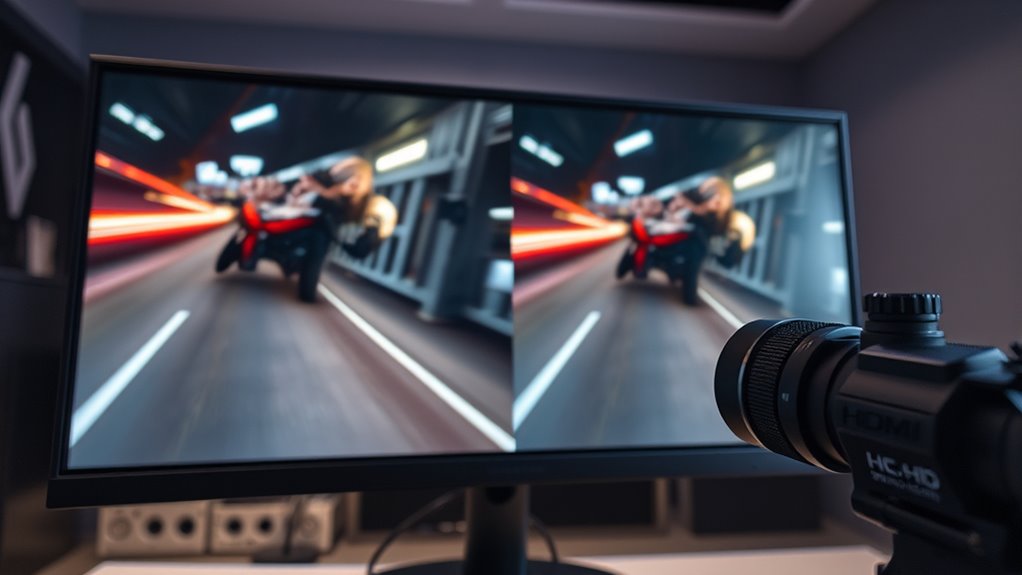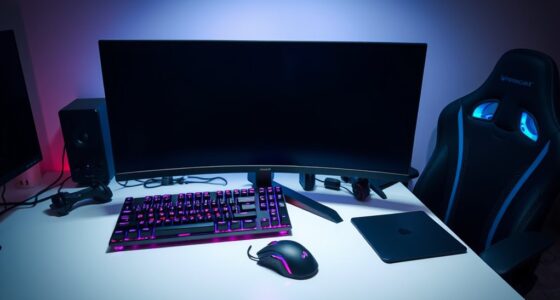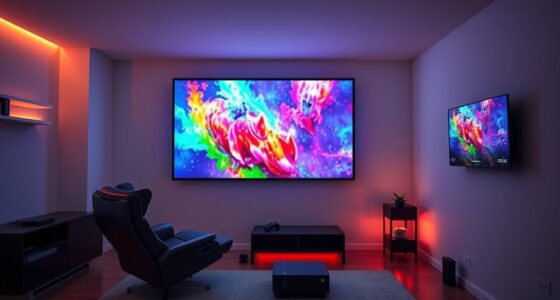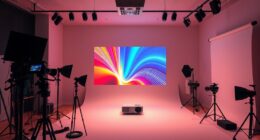HDMI input latency varies based on hardware components, cables, settings, and processing features. Factors like port design, signal conversion, and device performance impact response times. Using high-quality cables and enabling game modes can reduce delays. Different HDMI versions also play a role, with newer standards offering lower latency. If you want to understand how these elements stack up and how to optimize your setup, there’s more to discover below.
Key Takeaways
- Different HDMI ports may have varying hardware designs and shielding, affecting signal processing speed and latency.
- HDMI standards (e.g., 2.0 vs. 2.1) influence bandwidth and processing delay, impacting input lag.
- Cable quality and length can introduce delays; high-quality, shorter cables typically reduce latency differences.
- Device settings like game mode and low-latency options optimize HDMI input response times.
- Internal processing features, such as upscaling or HDR, can add delays, creating differences between HDMI inputs.
Factors Influencing HDMI Input Latency
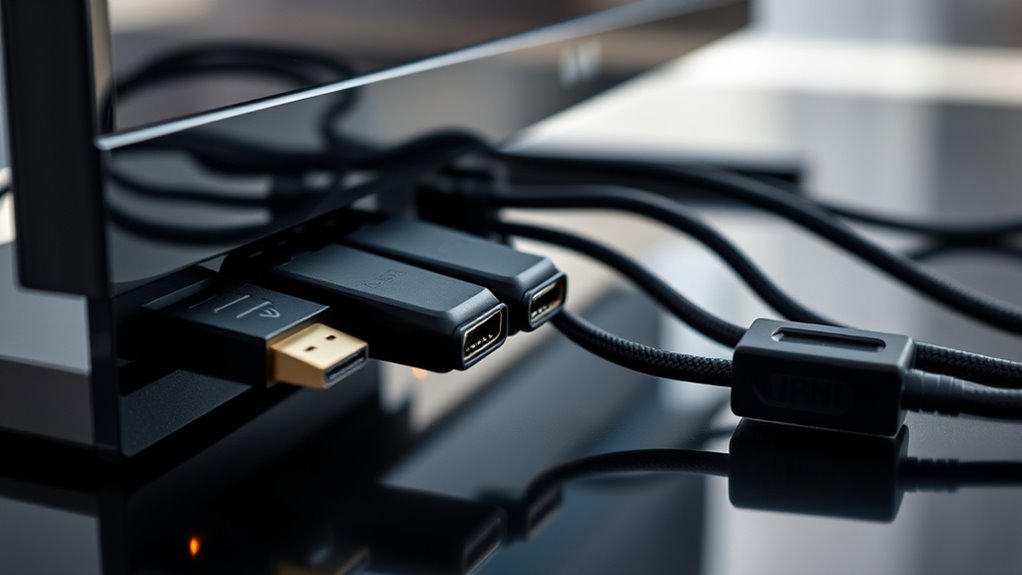
Several factors can affect the latency you experience when using HDMI connections. One key aspect is color calibration, which can introduce delays if adjustments are processed in real-time, impacting how quickly your display updates. Proper calibration guarantees accurate color reproduction without adding latency. Additionally, audio synchronization plays a role; if your audio and video are not perfectly aligned, it can cause noticeable delays, especially during fast-paced scenes or gaming. Devices that handle these processes differently can introduce varying levels of latency. Ensuring your HDMI setup minimizes processing, maintains proper calibration, and keeps audio synced helps reduce overall input lag. Being aware of these factors allows you to optimize your connection for a smoother, more responsive viewing and gaming experience. Understanding HDMI processing can further help identify and reduce sources of latency.
Hardware Components Affecting Signal Processing
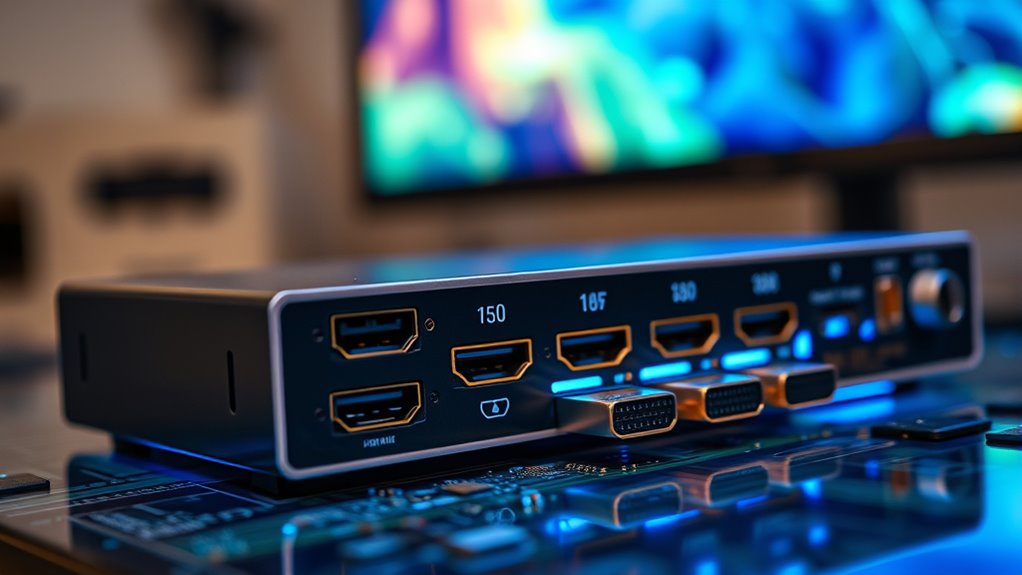
The hardware components within your HDMI devices directly influence how quickly signals are processed and transmitted. One key factor is the quality of the power supply, which guarantees stable voltage and reduces noise that can cause delays. A poor power supply may introduce analog interference, disrupting the signal and increasing latency. The internal circuitry, including the HDMI receiver and processing chips, also affects speed; advanced components process data more efficiently, reducing delay. Additionally, shielding and proper grounding help prevent analog interference, ensuring cleaner signals and faster processing times. When these hardware elements are optimized, they work together to minimize latency, providing a smoother viewing experience. Proper shielding and effective grounding techniques are essential for maintaining signal integrity and reducing potential delays, further enhancing overall HDMI signal performance. Conversely, subpar components or interference sources can introduce delays, impacting overall HDMI signal performance.
The Role of HDMI Cable Quality and Length
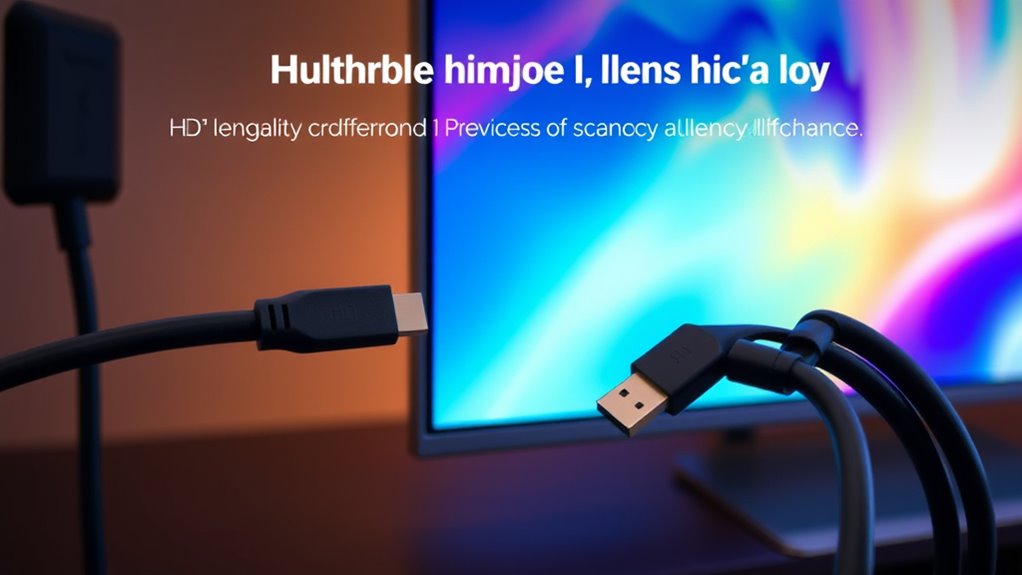
High-quality HDMI cables guarantee faster and more reliable signal transmission by maintaining consistent electrical performance. The HDMI cable quality directly impacts latency, as poorly made cables can introduce delays or signal degradation. Investing in certified, well-shielded cables minimizes interference and ensures a stable connection. Additionally, HDMI cable length influences latency; longer cables may cause signal attenuation or slight delays, especially if they aren’t designed for extended runs. Shorter, high-quality cables tend to deliver lower latency, providing a more responsive experience. When choosing an HDMI cable, prioritize quality over length for peak performance. Keep cable length as short as possible to reduce potential latency issues, but ensure it’s sufficient for your setup. Proper cable selection ensures minimal latency and consistent signal integrity. Using cables with proper shielding can further reduce electromagnetic interference and signal loss, enhancing overall performance.
Differences Between HDMI Versions and Standards

Choosing the right HDMI cable isn’t just about length and quality—it also depends on the HDMI version and standard it supports. Newer versions, like HDMI 2.0 and 2.1, offer higher bandwidth and lower latency, enhancing your experience. Compatibility is key; older cables may not support features like 4K at 120Hz or HDR. HDMI licensing guarantees standards are met, but cable compatibility varies. Here’s a quick comparison:
| HDMI Version | Max Bandwidth | Key Features |
|---|---|---|
| HDMI 1.4 | 10.2 Gbps | 1080p, 3D |
| HDMI 2.0 | 18 Gbps | 4K @ 60Hz, HDR |
| HDMI 2.1 | 48 Gbps | 8K, eARC, variable refresh rate |
| HDMI 2.0a | 18 Gbps | HDR support |
| HDMI 2.0b | 18 Gbps | Enhanced HDR |
Additionally, understanding the latency differences between HDMI versions can be important for gaming and real-time applications.
How Input Source Devices Impact Delay
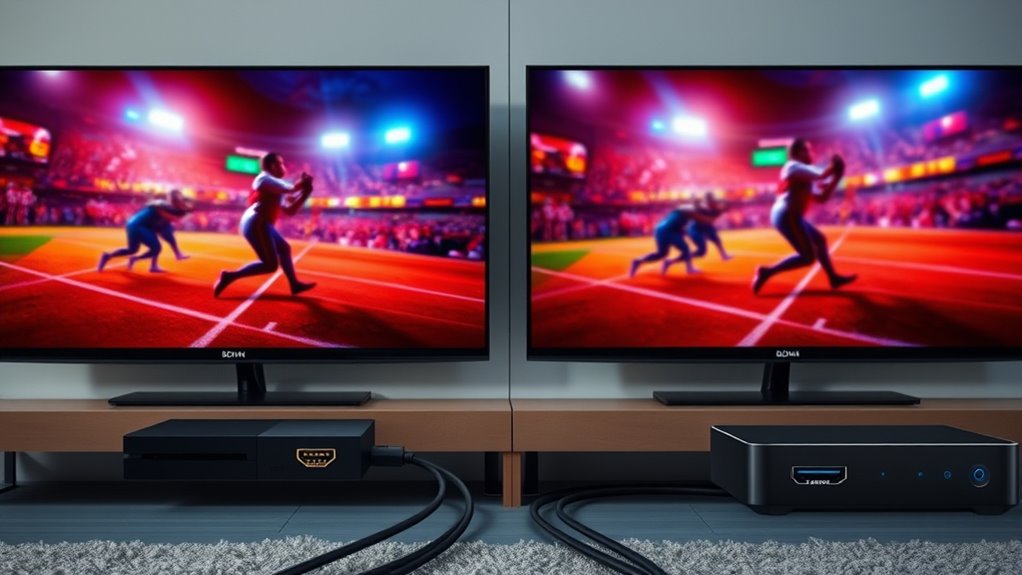
Input source devices play a significant role in determining HDMI latency because their processing capabilities and performance levels directly affect signal transmission speed. Variability among input devices, such as gaming consoles, Blu-ray players, or streaming boxes, can cause different delays even when connected to the same display. Some devices process signals faster due to superior hardware or optimized firmware. Firmware updates are essential, as they can improve device performance, fix bugs, and reduce latency. Additionally, device settings and performance modes influence processing times. By choosing high-performance input devices and keeping firmware updated, you can minimize delays and achieve a more synchronized, responsive viewing experience. Recognizing the emotional impact of delays on users can motivate manufacturers to prioritize faster processing and better user experience.
The Effect of Display Settings and Processing Features
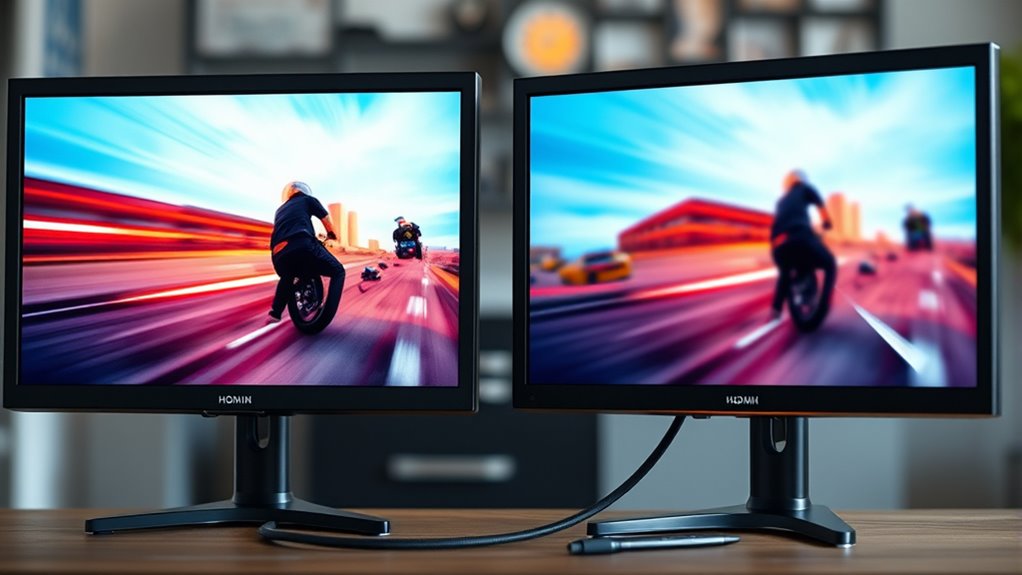
Your display’s picture mode and processing features can considerably affect HDMI latency. Enabling high-quality motion processing or choosing certain picture modes may introduce delays. Understanding how these settings influence response time helps you optimize for lower latency and better gaming or viewing experiences.
Picture Mode Influence
Display settings and processing features in picture modes considerably impact HDMI latency, often making a noticeable difference in gaming and fast-paced content. When you select different modes, options like color calibration and ambient lighting adjustments can either add or reduce latency. For example, gaming modes typically prioritize lower latency by disabling certain processing features, resulting in quicker response times. Conversely, modes with enhanced color calibration or ambient light reduction may introduce additional processing, increasing input delay. Understanding these trade-offs helps you optimize your display for your activities. If quick response is critical, choose a picture mode that minimizes processing, even if it sacrifices some visual enhancements. Adjusting these settings allows you to strike the right balance between image quality and latency based on your environment and usage. Additionally, being aware of display technology differences can further influence latency and overall performance.
Motion Processing Impact
Motion processing features, such as frame interpolation, motion smoothing, and ultra-smooth technology, can substantially affect HDMI latency by adding extra steps to how images are rendered. These features enhance picture smoothness but often introduce noticeable delay. When you enable motion smoothing, your display creates intermediate frames, which increases processing time and latency. This extra processing can cause a delay between your source signal and what you see on screen, impacting fast-paced gaming or real-time applications. To help you understand, here’s a comparison:
| Feature | Effect on Latency | Typical Use Case |
|---|---|---|
| Motion Smoothing | Increases delay | Watching movies, streaming |
| Frame Interpolation | Adds processing time | Enhancing motion clarity |
| Ultra-smooth Tech | Adds latency | Sports, fast action |
Turning off these features can notably reduce HDMI latency. Additionally, some displays offer gaming modes designed to minimize processing, further reducing latency and improving responsiveness.
Variations in HDMI Port Hardware Design
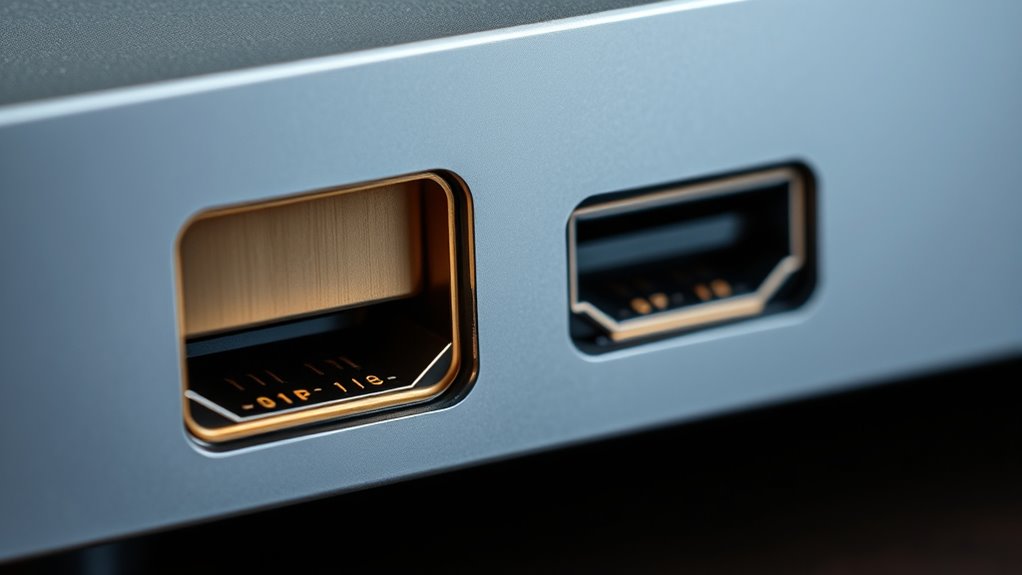
Variations in HDMI port hardware design can considerably impact latency and overall performance. The circuit layout inside the port influences how quickly signals travel, affecting response times. A streamlined, efficient layout minimizes signal delay, ensuring faster data transfer. Port shielding is also essential; well-shielded connectors reduce electromagnetic interference, which can cause signal degradation and latency spikes. Poor shielding may result in inconsistent performance, especially in environments with other electronic devices. Manufacturers might design ports with different circuit configurations, leading to varying levels of latency. You’ll notice that high-quality ports often feature optimized layouts and superior shielding. These improvements help maintain signal integrity, reduce delays, and deliver smoother, more responsive experiences when switching between HDMI inputs.
The Impact of Signal Conversion and Downscaling
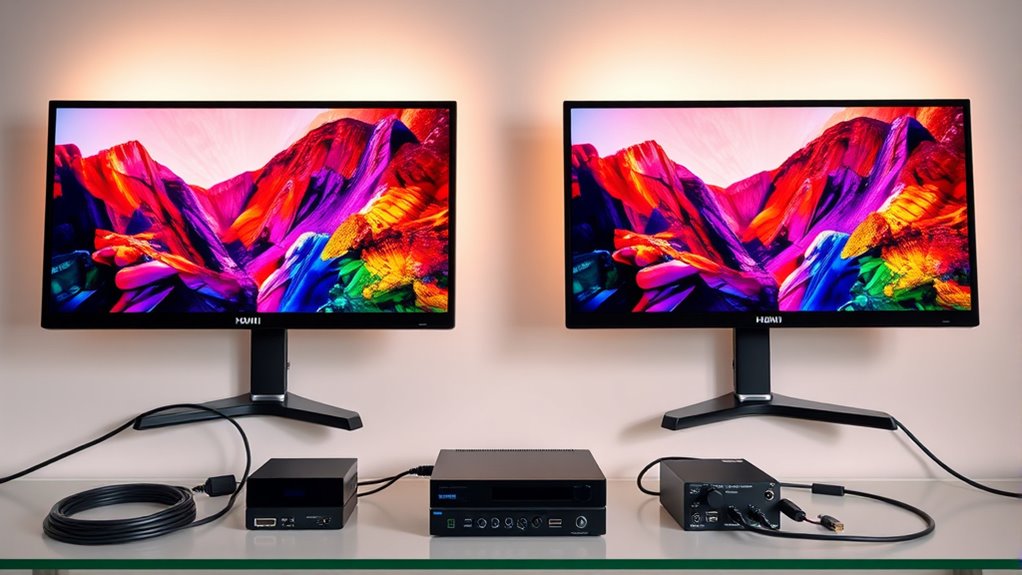
When HDMI signals undergo conversion or downscaling, the process can introduce additional latency that affects your viewing experience. Signal conversion involves transforming one digital format into another, while downscaling reduces resolution to match display capabilities. Both processes require processing time, which adds delay. The table below illustrates how different factors influence latency:
| Factor | Effect on Latency | Typical Impact |
|---|---|---|
| Signal Conversion | Increases processing time | 1-3 milliseconds |
| Downscaling | Adds rendering delay | 2-5 milliseconds |
| Hardware Quality | Varies based on device | Up to 2 milliseconds |
Understanding these impacts helps you choose equipment that minimizes latency, ensuring smoother, more responsive viewing. Awareness of signal processing techniques can further aid in optimizing your setup for minimal delay.
Tips for Measuring and Comparing HDMI Input Latency
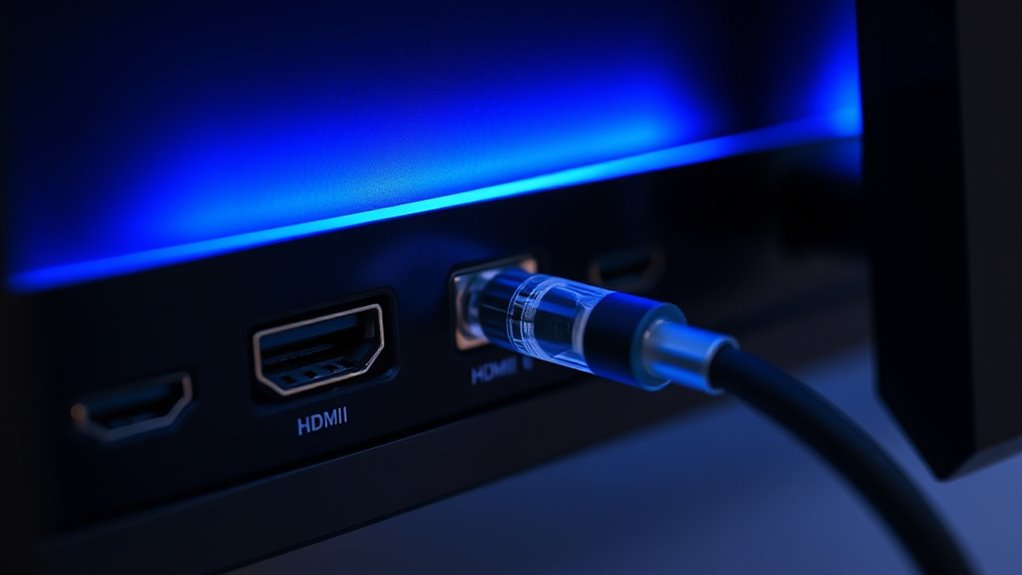
To accurately measure HDMI input latency, you should use reliable latency measurement tools designed for this purpose. Comparing signal processing times across different devices can help you identify which setup offers the minimal delay. By systematically testing and analyzing these factors, you can make better-informed decisions for your ideal viewing experience. Additionally, understanding industry trends can help you stay updated on the latest advancements in latency reduction techniques.
Using Latency Measurement Tools
Ever wondered how to accurately measure HDMI input latency? Using the right measurement tools is key to guaranteeing precision. First, select a reliable latency measurement device that offers high measurement accuracy and supports calibration techniques. Second, perform calibration techniques to eliminate interference and standardize your setup, which enhances measurement reliability. Third, conduct multiple tests to verify consistency and identify any anomalies. Keep in mind, consistent calibration techniques are essential for accurate comparisons across different HDMI inputs. By following these steps, you’ll obtain precise latency data, making it easier to analyze differences. Using proper measurement tools and calibration techniques minimizes errors, giving you confidence in your results. This approach ensures you’re equipped to compare HDMI input latencies with clarity and confidence. Incorporating tuning techniques can also help optimize your system performance for better overall results.
Comparing Signal Processing Times
Comparing signal processing times across different HDMI sources requires careful measurement and analysis. To do this effectively, you should use test patterns or standardized video signals that highlight processing delays. Keep in mind that video compression can affect latency, especially when dealing with streaming sources, so measure under consistent conditions. When comparing processing times, consider how each device handles color accuracy, as some may introduce additional delay to preserve color fidelity. Use a high-speed camera or latency measurement tools to record the time from input to display. By focusing on these factors, you’ll obtain a clearer picture of each HDMI source’s processing speed, helping you identify which devices introduce minimal latency and maintain best visual quality.
Strategies to Minimize Delay Across HDMI Ports
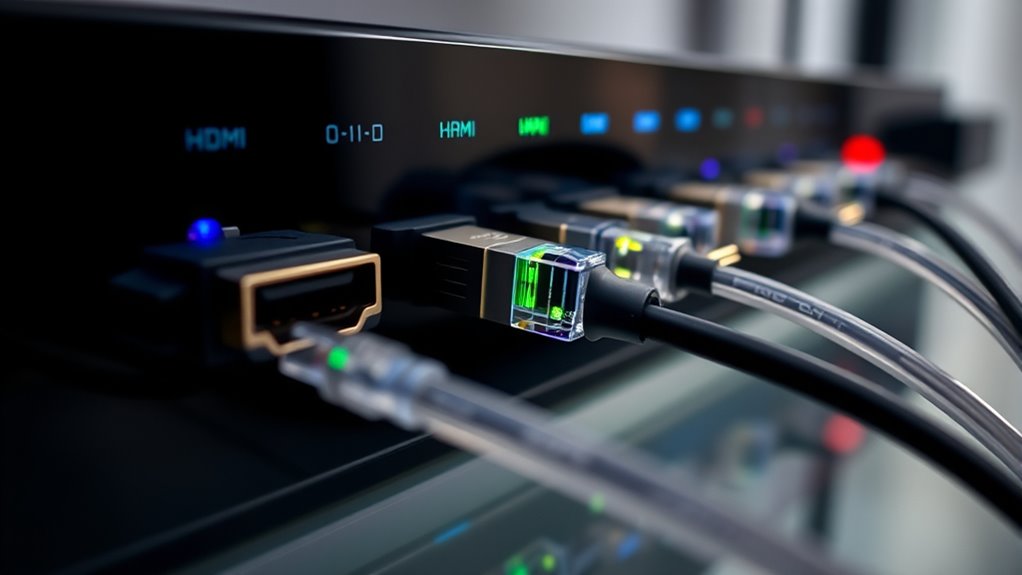
Minimizing delay across HDMI ports is essential for ensuring smooth, responsive multimedia experiences. To achieve this, consider these strategies:
- Reduce network congestion by limiting simultaneous internet usage, preventing bandwidth issues that can add latency.
- Optimize ambient lighting in your viewing area, as harsh or inconsistent lighting can cause display processing delays.
- Update firmware and drivers regularly to ensure your HDMI devices operate with the latest optimizations for minimal latency.
Implementing these steps helps streamline signal processing, cut down on unnecessary delays, and improve overall responsiveness. By managing network traffic and creating an ideal viewing environment, you can considerably reduce HDMI port latency, making your multimedia experience more seamless.
Frequently Asked Questions
How Do HDMI Input Latency Differences Affect Competitive Gaming Performance?
HDMI input latency directly impacts your gaming performance by increasing input lag, making your actions feel delayed. When there are differences in HDMI input latency, your reflexes may suffer, and your timing could be off during fast-paced, competitive gaming. To stay ahead, you should choose HDMI inputs with lower latency, enable game mode, and minimize any unnecessary processing to reduce gaming latency and improve your overall response time.
Can Firmware Updates Reduce HDMI Input Delay on My Display Device?
Yes, firmware updates can reduce HDMI input delay on your display device. These updates often optimize refresh rate management and improve color calibration, which can lower latency. Keep your device’s firmware current to benefit from these enhancements. Additionally, adjusting your display’s settings for a lower latency mode and ensuring your HDMI cable supports high refresh rates can further minimize input delay, boosting your gaming experience.
Are There Specific HDMI Port Designs That Inherently Have Lower Latency?
Yes, some HDMI port designs inherently have lower latency due to better HDMI port quality and optimized internal circuitry design. Higher-quality ports often feature improved shielding, reduced interference, and streamlined signal pathways, which help minimize delay. When choosing a display, look for models that specify low-latency HDMI ports or advanced internal circuitry design. These enhancements can markedly reduce input lag, especially important for gaming or real-time applications.
How Does HDMI Handshake Timing Influence Input Delay?
Imagine you’re in a vintage arcade, waiting for your turn. The HDMI handshake timing directly influences your input delay by establishing communication between your device and display. When the handshake takes longer, it adds to input delay, making responses feel sluggish. A swift handshake minimizes this lag, ensuring your gameplay feels immediate. So, optimizing handshake speed can markedly improve your overall experience by reducing those frustrating input delays.
Do Different Display Manufacturers Implement Latency Optimizations?
Yes, different display manufacturers often implement latency optimizations through manufacturer customization and hardware integration. They fine-tune components and software to reduce input delay, especially in gaming or fast-paced content. Your experience varies based on the brand and model, as some prioritize low latency more than others. Always check for specific gaming modes or latency reduction features, which are often part of the manufacturer’s customization efforts to enhance performance.
Conclusion
By understanding the factors affecting HDMI input latency, you can optimize your setup for speed and smoothness. Focus on firmware, hardware, and cable quality to minimize delays. Remember, differences in devices, ports, and standards all contribute to latency levels. With careful consideration and some calibration, you can cut costs and chaos, creating a seamless, synchronized streaming experience. Stay savvy, streamline your setup, and enjoy your entertainment without unnecessary lag or lagging!
